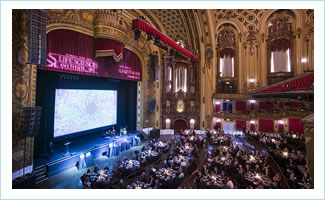
Over 520 attendees heard Salim Ismail address the challenges of Shifting from Linear to Exponential Thinking. Salim, founding Executive Director and Global Ambassador of Singularity University, presented data to help us appreciate the exponential missed opportunities of Kodak and impending opportunities in health care, energy and artificial intelligence. Salim also discussed the challenge of integrating disruptive technologies into large established companies and the internal antibodies of such companies that attack changes to the core technology. If you were unable to attend, please watch our website and twitter feed for the video of the presentation that will be posted soon.
Closing comments for the evening were made by board director Irv Hockaday, who stated, “It is our responsibility to make this happen…Our life sciences future, our regional future won’t,” quoting from Huck Finn “only just happen.”
Path to 2025

KCALSI Board Chair Bill Berkley and President & CEO Wayne Carter provided an overview of “Path to 2025” a 10-year vision and plan that positions the region at the nexus of human and animal health. The complete report is available online at http://kclifesciences.org/news/path-to-2025/ and includes recommended steps to keep the region globally competitive.
KCALSI retained Deloitte to conduct the regional strategic assessment, and the resulting report was based on interviews with more than 150 area leaders and a survey sent to more than 1,200 people. It follows KCALSI’s original strategic plan issued in 2005 that identified opportunities including animal health and nutrition, leading to the development of the Kansas City Animal Health Corridor. According to the Path to 2025 Report, the Kansas City region has a number of strengths in the life sciences, notably health information technology represented by Cerner Corp. along with many other established and startup companies, entrepreneurial and infrastructure assets in this sector. “The health IT combined with the world-class outcomes research expertise creates an ecosystem opportunity for Kansas City similar to the Animal Health Corridor ten years ago,” stated Dr. Carter. Other strengths that will be a source of future focus include Animal Health, Neuroscience and Cancer Research and Care. Animal Health with a well-established national and international reputation is poised for future growth when the National Bio and Agro Defense Facility is completed and opens in Manhattan in 2021.
The Report also identifies regional weaknesses that threaten future growth. The Kansas City region has made strides in the past decade toward becoming a major life sciences industry hub, but enhanced access to capital formation for startup companies and a better educated workforce are critical to keep Kansas City growing in life sciences. Despite its reputation for entrepreneurship, the Kansas City area falls short on attracting venture capital and angel investors, the report said. Dr. Carter noted that “If we do nothing, yes, we’ll grow, but we won’t attract entrepreneurs and investors to our region and we will continue the risk of losing the next Cerner.” Even taking the size of their economies into account, Kansas and Missouri get just a small fraction of the venture capital investment of major biotech states like Minnesota, Washington and Massachusetts. Kansas City also trails other cities for high-tech talent with just 9.3 percent of residents holding college degrees in science, technology, engineering or math. High school students in Kansas and Missouri also are less likely to score well on Advanced Placement exams in calculus and biology than students nationwide, boding poorly for the future.
“There is great opportunity for our future”, said Dr. Carter, “But we have to correct the identified weaknesses and focus on our strengths.” The vision statement looks for the nexus of human and animal health which plays to our core strengths and the vision also looks to improve healthcare for all our citizens and reduce healthcare disparities.
Science to Art

This year’s second annual “Science to Art” silent auction featuring the intrinsic art found in biomedical research was again a huge success. Scientists from across the region submitted images that were professionally curated, printed, and framed. Please watch the video below that highlights this year’s scientists and their incredible passion for STEAM (STEM and Art). This year’s auction yielded proceeds of $5,382. Because of the importance in supporting education as identified in Path to 2025, KCALSI is matching these proceeds to make over $10,000 available for “STEAM” education, specifically BioGenius, Prep-KC, Science Pioneers and Artist, Inc.